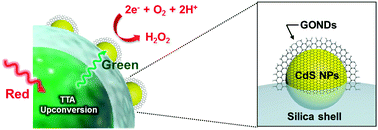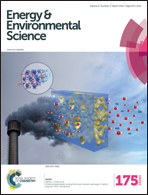Harnessing low energy photons (635 nm) for the production of H2O2 using upconversion nanohybrid photocatalysts†
Abstract
This study demonstrates, for the first time in literature, in situ photocatalytic synthesis of hydrogen peroxide (H2O2) through sensitized triplet–triplet annihilation (TTA) upconversion (UC) of low-energy, sub-bandgap photons. The aqueous phase TTA-UC and subsequent photocatalytic oxygen reduction were achieved by a newly developed ternary nanohybrid that consists of three components: (1) a nano-scale silica core–shell structure that encapsulates TTA-UC chromophore-containing media; (2) a low-bandgap CdS photocatalyst on the surface of the silica nanocapsule; and (3) a graphene oxide nanodisk (GOND) as a co-catalyst. In this study, we employed a benchmark TTA-UC chromophore pair, palladium(II) tetraphenyltetrabenzo-porphyrin sensitizer and 9,10-bis(phenylethynyl)anthracene acceptor, to upconvert red photons (λEx = 635 nm and 1.95 eV) to green photons (λEm = 505 nm and 2.45 eV). CdS is sensitized by upconverted green light to produce charge carriers, but not by incident red light without TTA-UC. The photogenerated electrons are efficiently transferred to a GOND to retard rapid charge recombination in CdS, which subsequently reduce dioxygen to produce H2O2 up to a 100 micromolar level per hour (or 3 mg L−1 h−1 with 0.5 g L−1 of GOND/CdS component only). Wrapping of CdS by a GOND was also found to markedly enhance the stability of CdS against photocorrosion without light shielding owing to its small size (ca. ∼80 nm) and transparency (α635nm = 1.85 g−1 dm3 cm−1).


 Please wait while we load your content...
Please wait while we load your content...